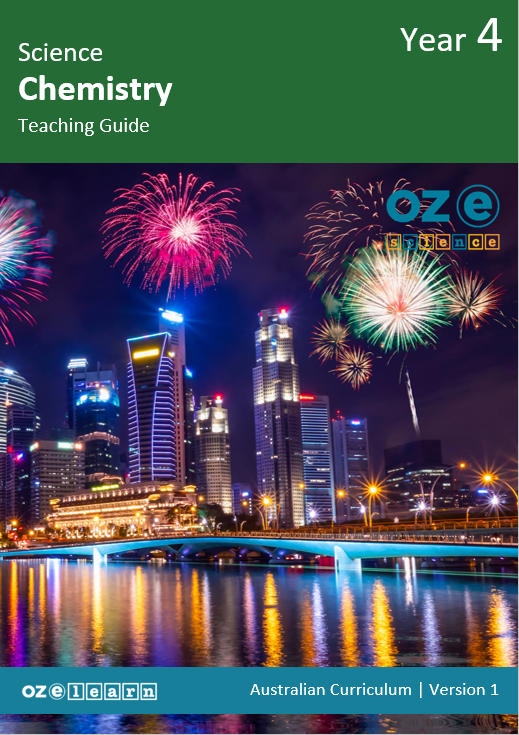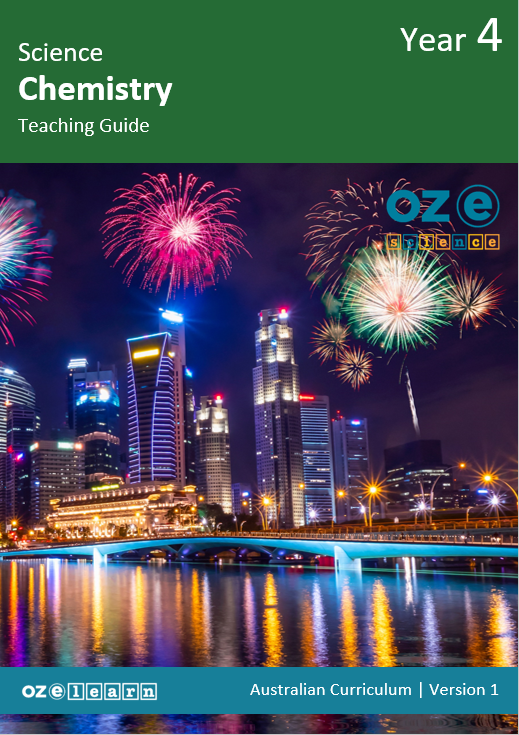Oz-e-science Years F–6
Chemistry Year 4

Teaching resources
Lessons:
- Teaching Guide
- Student Workbook
- Final Assessment
- Student Songbook
Extra resources
Lessons:
- Classroom posters
- Element Club Handbook
Overview
Chemistry Year 4 is a Chemical Sciences curriculum program for Year 4 students. It aligns to the Australian Curriculum Science Understanding:
- Natural and processed materials have a range of physical properties that can influence their use (ACSSU074)
Note: This curriculum program is currently being updated to align with the Australian Curriculum 9.0, updated versions will be released in early 2024.
Success criteria
- Explain the formation of hydrogen and helium.
- Label the parts of a hydrogen and helium atom.
- Identify the first two elements created.
- Represent the first two elements by making a model of their atoms.
- Identify some of the first 18 elements in the periodic table.
- Represent the elements on some playing cards.
- Identify the physical properties of elements.
- Record the physical properties of elements.
- Make a model of the molecular structure of diamond.
- Identify the physical properties of elements.
- Record the physical properties of elements.
- Identify the main elements in the human body.
- Represent the main elements in an outline of the human body.
- Record the elements in healthcare products.
- Analyse the benefits of the elements in the healthcare products.Ask a scientific question.
- Develop a hypothesis.
- Make a prediction.
- Conduct the experiment.
- Make observations.
- Conduct part two of the experiment.
- Record observations.
Learning objectives
In Lessons 1 to 9, students learn about:
- everything in the universe is made up of very small particles called atoms
- the first two and most common elements in the universe – hydrogen and helium.
- some of the first 18 elements of the periodic table.
- the physical properties of elements.
- the main elements that make up the human body.
- the elements that are present in healthcare products, and their benefits
- and conduct part one of the experiment by following the Scientific Method.
- and conduct part two of the experiment by following the Scientific Method.
Assessment
Progress tests
Progress tests are conducted after every second lesson, allowing teachers to monitor student understanding of the concepts taught over the past two lessons and to identify where reteaching is needed.
The Teaching Guide contains the testing questions, and the Student Workbook has a section where students write their answers and score themselves.
Structured Research Activity
The Structured Research Activity (SRA) for this unit is:
Students plan, conduct and report on an experiment to test the effectiveness of toothpaste at removing stains.
The SRA takes place over two lessons so students can apply the Science Understanding and Science Inquiry Skills covered in the unit.
Teachers use the Guide to Making Judgements, which is included in the Teaching Guide, to mark the SRA.
End-of-unit assessment
The last lesson is the end-of-unit assessment, which has a variety of question formats (e.g. label the diagram, circle the correct answer) to assess student mastery of content from the unit.
The end-of-unit assessment is in the Teaching Guide. Teachers copy the assessment and distribute to students at testing time.
Explicit instruction for Science
Oz-e-science uses a teaching approach and curriculum that uses explicit teaching of content knowledge of science and explicit teaching and practical scientific inquiry using the Scientific Method. Read more about pedagogy here.


